Research projects in the field of PV technologies
-
StrukturSolar
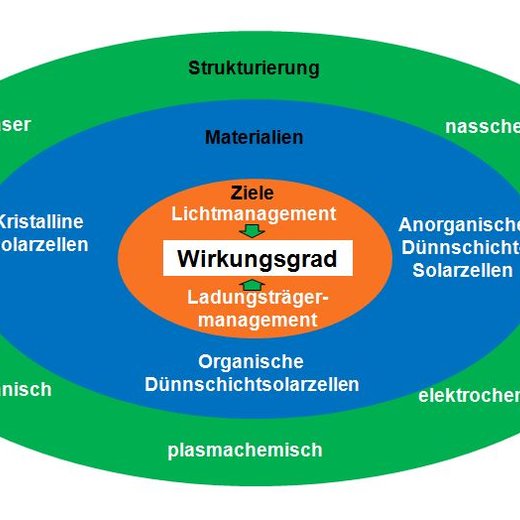
Project structure of StrukturSolar
Cooperative Research Center – StrukturSolar – Innovative structuring concepts for next generation solar cells (grant No. 03SF0417A)
... is one of seven pilot projects funded by the German Federal Ministry of Research and Technology (BMBF), in which the competencies of universities of applied sciences and universities in basic research are to be used in a joint research project in a complementary manner. The project focuses on research projects by young scientists who are jointly supervised by both universities and who wish to gain further qualifications with their research by completing a doctorate.
Various structuring methods (plasma-chemical, wet-chemical, electrochemical, mechanical, by laser) – with which Anhalt University of Applied Sciences and Martin Luther University have application and basic research and development experience – are to be used in innovative concepts to optimize light and charge carrier management in solar cells. The idea is to keep an eye on cost-effective technological feasibility from the outset, so that the research work can lead to an increase in the efficiency of solar cells with a relatively lower increase in manufacturing costs. Both crystalline silicon solar cells (targeting thinner wafers than is common today) and thin film solar cells (copper indium/gallium diselenide (CIGS) and organic solar cells) are being studied.
Eight research assistants are working as doctoral students under the supervision of 13 university professors and researchers from both universities on various complementary research tasks of the project. The 13 university professors and researchers involved possess material science and technology-oriented expertise in photovoltaics as well as methodological skills in the aforementioned structuring processes or in relevant scientific analysis methods for material or solar cell characterization.
After the successful completion of StrukturSolar on September 30, 2015, the funding for the follow-up project StrukturSolar II was granted from October 1, 2015 until September 30, 2018. Research content will be the continuation of particularly successful topics from the first phase, partly with a new focus, but also some new topics, such as PERC (Passivated Emitter and Rear Contact) cells or perovskite/silicon tandem cells.
-
LASER-PV
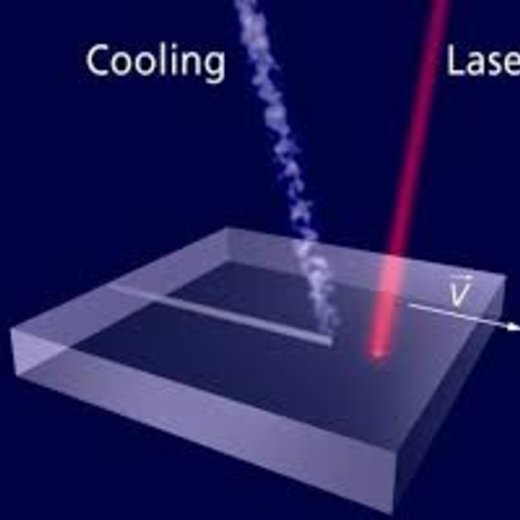
Principle representation of the TLS process
BMBF Funding Program “IngenieurNachwuchs – Kooperative Promotionen” – LASER-PV – Application of laser separation processes in photovoltaics
Funding period: October 1, 2014 – September 30, 2017
Cooperation partners: Fraunhofer IISB, ISE and CSP, Hanwha Q-Cells, 3D-Micromac
The content of the project is basic investigations and process optimization for the novel process of thermal laser separation (TLS) in the separation of silicon, germanium and gallium arsenide wafers for the application in (concentrating) photovoltaics. In addition, comparative investigations are carried out with the reference processes: ablative laser cutting (possibly in combination with mechanical breaking) and mechanical sawing.
-
Solar-TLS
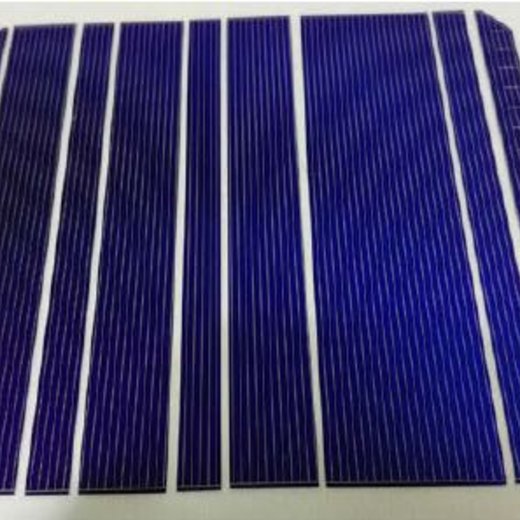
Bifacial solar cell divided by TLS method
Joint project – Solar-TLS – Development of novel and production-suitable solar cell separation processes based on thermal laser separation
Project duration: May 1, 2016 – April 30, 2018; extended until October 31, 2018 (cost-neutral)
Project partners: 3D-Micromac Chemnitz, Fraunhofer CSP Halle (Saale)
In a joint project, research and development work was carried out on the thermal laser separation process with the aim of developing TLS processes suitable for production for the manufacturing of silicon half-cells for high-performance modules (or sub-cells for special modules). The main focus was on replacing the aerosol cooling which is normally used with a dry cooling process. For this purpose, a vortex tube nozzle was installed at the TLS facility of Anhalt University and a corresponding dry cooling process was developed. Multi- and mono-crystalline silicon solar cells based on PERC technology were equally investigated. In a final work phase, separation experiments were successfully performed on bifacial cells.
-
Black-SiN
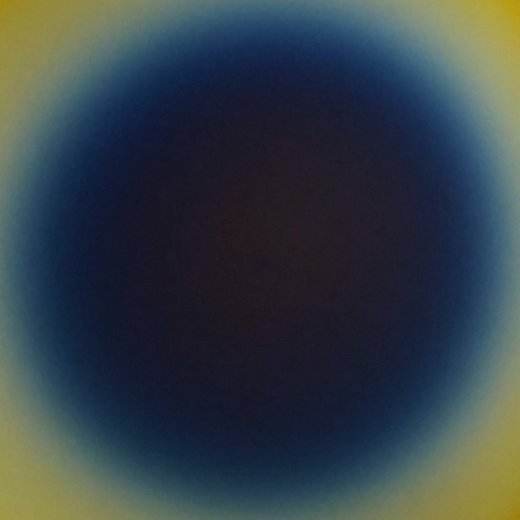
Photography of a plasma-textured silicon nitride layer
Joint project – Black SiN – Maskless plasma texturing of silicon nitride
Duration period: The ERDF project funded by the state of Saxony-Anhalt was approved for the period from April 1, 2018 to March 31, 2020.
As of March 12, 2020, the duration of the project could be extended until May 31, 2020 with no impact on expenditure or costs.
Project partners: Fraunhofer Center for Silicon Photovoltaics CSP, Halle (Saale)
In the current Black SiN research project, Prof. Bernhard and his team of scientific assistants are conducting research on reducing the reflectance – and thus improving the light absorption – of industrial silicon solar cells. In cooperation with the Fraunhofer Center for Silicon Photovoltaics CSP in Halle (Saale), the project is conducting research on maskless plasma texturing of silicon nitride layers without damaging the underlying silicon wafer. From the increased light absorption follows an improvement in solar cell efficiency. The patent-pending process will eventually be transferred to industrial production.
-
MILLEFEUILLE
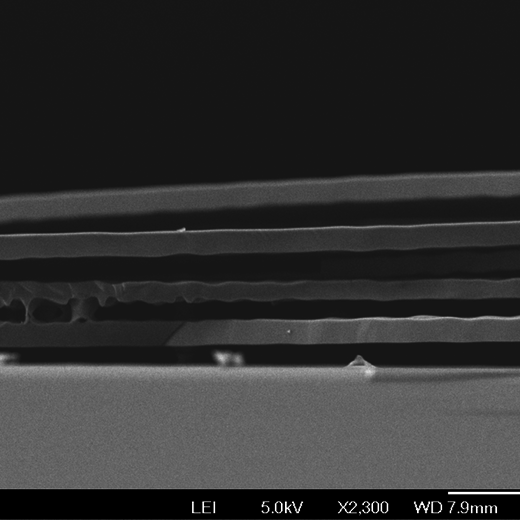
SEM image of multiple ultrathin silicon wafers
Joint project – MILLEFEUILLE – Materials and technologies for the direct production of multiple ultra-thin silicon wafers
Duration period: August 1, 2017 – October 31, 2020
Project partners: Smartmembranes, Halle (Saale)
The MILLEFEUILLE project aims to provide the scientific and technological basis for the cost-efficient and scalable (i.e. transferable to industry) production of ultra-thin monocrystalline silicon wafers using the empty space in silicon (ESS) process as well as the demonstration of their texturability by a maskless plasma etching method.
The focus of the project is on the development and evaluation of new processes and technologies for the production of ultra-thin monocrystalline silicon wafers (10 µm - 50 µm) from 3D macroporous silicon in one process step ("millefeuille") by depth modulation of the photo-electrochemical etching process with subsequent tempering as well as their effective plasma texturing to achieve sufficient light absorption by reducing reflection and effective light trap structures for photovoltaic applications.
The funding by the Investitionsbank Sachsen-Anhalt and the European Union within the framework of the ERDF program is acknowledged gratefully.
Extended abstract submitted to EUPVSEC: Abstract
-
LeTID-Norm

LeTID Consortium Logo
Joint project – LeTID-Norm – Development of a test standard for light- and temperature-induced degradation (LeTID) of high-efficiency solar cells and modules
Project duration: January 1, 2019 – December 31, 2020 (extended until June 30, 2021)
Project partners: Fraunhofer Center for Silicon Photovoltaics CSP, Anhalt University of Applied Science, centrotherm international AG, DKE German Commission for Electrical, Electronic & Information Technologies of DIN and VDE, Hanwha Q Cells, Wavelabs GmbH
Associated partners: Mayer Burger AG, LayTec AG, IBC Solar AG
The project LeTID-Norm receives funding within the WIPANO program of the German Federal Ministry for Economic Affairs and Energy (BMWi).
In recent years a new type of degradation called LeTID which can lead to significant power losses in solar cells has become a focus of discussion. LeTID stands for Light and elevated Temperature Induced Degradation. Cells with innovative designs like PERC technology show an even stronger effect than cells with a standard setup.
At the moment, however, there is no standardized testing method to quantify the LeTID phenomenon. Currently available tests differ vastly regarding their parameters like the type of charge carrier injection and operating mode. The effects of enhanced temperature are often not considered.
The project LeTID-Norm aims at providing a harmonized approach to LeTID testing along the value chain of solar modules and establishing an integrated quality management system to avoid LeTID/LID losses. This approach will be proposed for standardization nationally and to IEC after the end of the project.